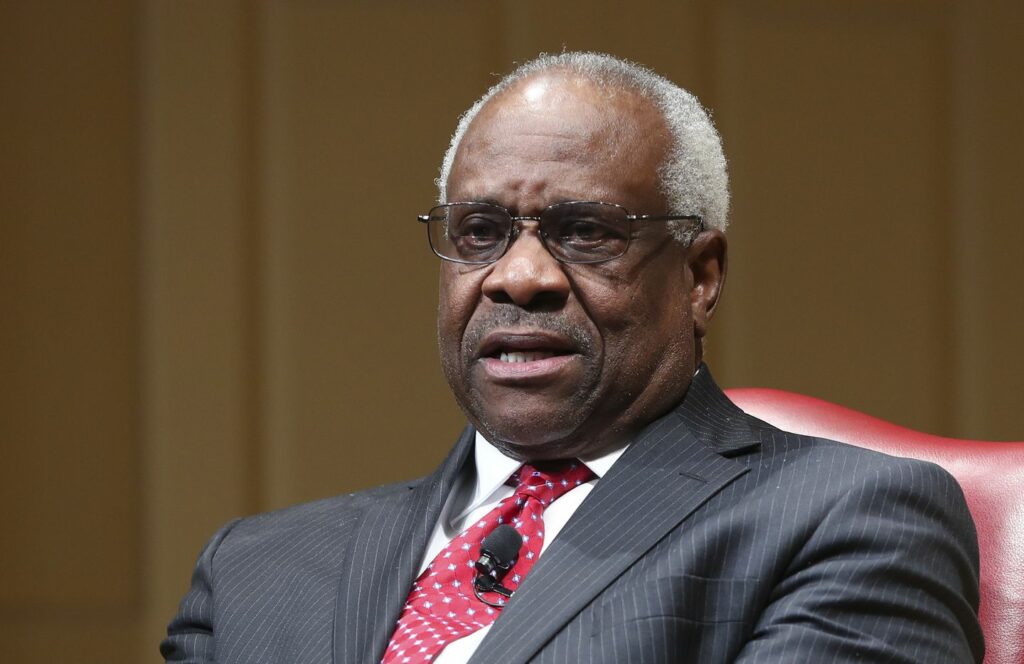A Supreme Court justice gets it in his mind to ask a question, and pretty soon, he’s got questions for everyone. And so the next question: Will Clarence Thomas ever stop talking?
Before this week, the intervals between Thomas’ questions during high court arguments were measured in years. He once went 10 years, from 2006 to 2016, without asking even one.
Now he’s been an active questioner for three straight days. He’ll have the chance to continue his streak next week in six arguments over three days.
It might be the setting, the court’s first arguments by telephone, because of the coronavirus pandemic.
“I must say, as a former clerk, I’m delighted that a silver lining of the new format in this difficult time is that the public can see the extraordinary combination of preparation, thoughtfulness, and grace the Justice brings to every case,” Elizabeth Papez, partner in a big Washington, D.C., law firm said in an email.
The new arrangement has made for more structured proceedings, with justices taking turns instead of jumping in whenever they wanted. Only Chief Justice John Roberts goes before Thomas, the longest-serving justice. He joined the court in 1991.
One reason Thomas, 71, has given over the years for his reticence is that he thinks his colleagues talk too much and don’t give the lawyers before them the courtesy of presenting arguments they have sweated over for weeks and months.
“It confirms in one sense what Justice Thomas has said about the excessive interruptions,” said Nicole Stelle Garnett, a University of Notre Dame law professor who once worked for Thomas.
The contrast between Thomas on the phone and in person is stark.
In the courtroom, the justice often reclines in his chair, his gaze toward the decorative ceiling, not on the lawyer who is arguing. Occasionally, he will lean forward, approaching his microphone and putting reporters on alert that he might break his silence.
Almost always, it’s just a feint.
But on the phone, he’s had questions for every lawyer, although he went out of order Wednesday because of temporary technical difficulties.
___
In another time, Justice Ruth Bader Ginsburg arranged her medical care around the court’s schedule so she wouldn’t miss arguments.
On Wednesday, the 87-year-old Ginsburg was able to participate from a Baltimore hospital, where she is being treated for an infection caused by a gallstone. It’s an unforeseen option after the court’s virus-driven decision to hold remote arguments.
When Ginsburg was receiving treatment following surgery for colorectal cancer in 1999, she followed advice from the first woman on the court, Justice Sandra Day O’Connor, who was back in court nine days after breast cancer surgery.
“Ruth, you schedule your chemotherapy for a Friday. Then you can get over it on Saturday and Sunday and be back in court on Monday,” Ginsburg said last year, quoting O’Connor, at a Clinton Foundation event in Little Rock, Arkansas.
Illness does sometimes keep justices from the courtroom. Ginsburg herself missed arguments for the first time since joining the court in 1993 as she recovered from surgery to remove cancerous growths on her lung in 2018.
Chief Justice William Rehnquist missed 44 arguments when he was dealing with the thyroid cancer to which he eventually succumbed in 2005. Justice William Douglas didn’t return to the bench for nearly six months after he broke 14 ribs and punctured a lung in a horseback riding accident on the day before the Supreme Court term began in October 1949.
(AP)











